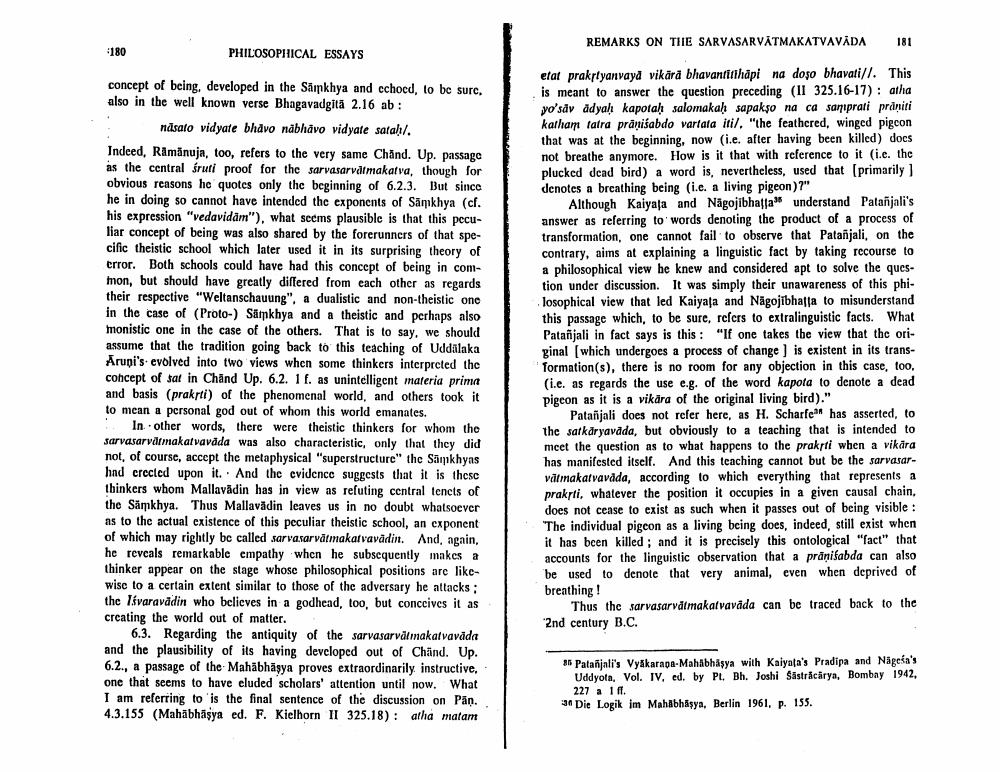Book Title: Remarks On Sarvasarvatmakatvavada Author(s): A Wezler Publisher: A Wezler View full book textPage 8
________________ REMARKS ON THE SARVASARVATMAKATVAVADA 181 :180 PHILOSOPHICAL ESSAYS concept of being, developed in the Sarpkhya and cchocd, lo be sure. also in the well known verse Bhagavadgita 2.16 ab : . nasalo vidyate bhavo nabhavo vidyate salah/. Indeed, Ramanuja, too, refers to the very same Chand. Up. passage as the central sruti proof for the sarvasarvatmakalva, though for obvious reasons he quotes only the beginning of 6.2.3. But since he in doing so cannot have intended the exponents of Sankhya (cf. his expression "vedavidam"), what seems plausible is that this peculiar concept of being was also shared by the forerunners of that specific theistic school which later used it in its surprising theory of crror. Both schools could have had this concept of being in common, but should have greatly differed from each other as regards their respective "Weltanschauung", a dualistic and non-theistic one in the case of (Proto-) Samkhya and a theistic and perhaps also monistic one in the case of the others. That is to say. we should assume that the tradition going back to this teaching of Uddalaka Aruni's evolved into two views when some thinkers interpreted the concept of sat in Chand Up. 6.2. 1 f. as unintelligent materia prima and basis (prakrti) of the phenomenal world, and others took it to mean a personal god out of whom this world emanates. :. In other words, there were theistic thinkers for whom the sarvasarvatmakalvavada was also characteristic, only that thcy did not, of course, accept the metaphysical "superstructure" the Samkhyas had crccled upon it. * And the evidence suggests that it is thesc thinkers whom Mallavadin has in view as resuting central tencts of the Samkhya. Thus Mallavadin leaves us in no doubt whatsoever as to the actual existence of this peculiar theistic school, an exponent of which may rightly be called sarva.sarvatmakatvavadin. And, again. he reveals remarkable empathy when he subsequently makes a thinker appear on the stage whose philosophical positions are likewise to a certain extent similar to those of the adversary he attacks ; the lisvaravadin who believes in a godhead, too, but conccives it as crcating the world out of matter. . 6.3. Regarding the antiquity of the sarvasarvatmakatvavadn and the plausibility of its having developed out of Chand. Up. 6.2., a passage of the Mahabhasya proves extraordinarily. instructive, one that seems to have eluded scholars' attention until now. What I am referring to 'is the final sentence of the discussion on Pan. 4.3.155 (Mahabhasya ed. F. Kielhorn II 325.18): alha malam etat prakriyanvaya vikara bhavantitihapi na doso bhavati/l. This is meant to answer the question preceding (II 325.16-17): atha yo'sav adyah kapotah salomakah sapakso na ca saniprati praniti kathan falra pranisabdo vartala itil. "the feathered, winged pigcon that was at the beginning, now (i.e. after having been killed) does not breathe anymore. How is it that with reference to it (i.e. the plucked dcad bird) a word is, nevertheless, used that (primarily ) denotes a breathing being (i.e. a living pigeon)?" Although Kaiyata and Nagojibhaffa36 understand Patanjali's answer as referring to words denoting the product of a process of transformation, one cannot fail to observe that Patanjali, on the contrary, aims at explaining a linguistic fact by taking recourse to a philosophical view he knew and considered apt to solve the ques tion under discussion. It was simply their unawareness of this phi.. losophical view that led Kaiyata and Nagojibhafta to misunderstand this passage which, to be sure, refers to extralinguistic facts. What Patanjali in fact says is this : "If one takes the view that the original (which undergoes a process of change ) is existent in its transformation(s), there is no room for any objection in this case, too, (i.e. as regards the use e.g. of the word kapota to denote a dead pigeon as it is a vikara of the original living bird)." Patanjali does not refer here, as H. Scharfens has asserted, to the satkaryavada, but obviously to a teaching that is intended to mcet the question as to what happens to the prakrti when a vikara has manifested itself. And this teaching cannot but be the sarvasarvatmakatvavada, according to which everything that represents a praksti, whatever the position it occupies in a given causal chain, does not cease to exist as such when it passes out of being visible : *The individual pigeon as a living being does, indeed, still exist when it has been killed ; and it is precisely this ontological "fact" that accounts for the linguistic observation that a pranisabda can also be used to denote that very animal, even when deprived of breathing! Thus the sarvasarvalmakarvavada can be traced back to the '2nd century B.C. 86 Patanjali's Vyakarapa-Mahabhasya with Kaiyata's Pradipa and Nagesa's Uddyota, Vol. IV, ed. by Pt. Bh. Joshi Sastracarya, Bombay 1942, 227 a 1 ff. :36 Die Logik im Mahabhasya, Berlin 1961, p. 155.Page Navigation
1 ... 6 7 8
